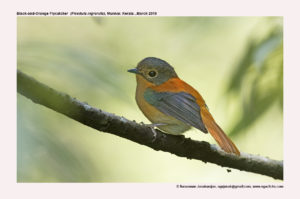Black-orange Flycatcher

Black & Orange Flycatcher Ficedula nigrorufa
Etymology:
- Ficedula : Latin word ficedula –small fig-eating bird
- Nigrorufa: Latin Word niger –black ; rufus – red
Vernacular Names : Mal: Menippakshi
Distribution in India: Resident of Western Ghats in India.
Description: Size of 11–13 cm; Wt. of 7–10 g. It is a small, compact black-and-orange flycatcher. The male has black head and face is sharply divided from orange-rufous of upperparts, including tail. The upperwing-coverts and flight-feathers are black. It is pale orange-rufous below, except for whitish lowermost underparts. The iris is hazel-brown; bill is dark horn or blackish-brown; legs are greyish-pink or grey-brown. The female is similar to male but duller, has dark olive-blackish head and face, with pale buffish lores, eyering and streaks on cheek, brownish-black wings, usually paler on belly. The juvenile is similar to adult, but orange-rufous replaced with dark brown and spotted paler brown or buffish-brown, with wings and tail as female. It is found in undergrowth, evergreen hill forest, also moist rattan thickets in ravines near streams, and occasionally edges of cardamom and coffee plantations. It is found above 700 m.
Food Habits: It eats small invertebrates and larvae, spiders. It is found solitary or in pairs; tame and often approachable. It forages low down, hopping on ground and in damp, dense undergrowth. It also makes short aerial sallies from low perch after flying insects. The peak feeding activity of the birds is early in the morning and towards dusk
Breeding Habits: They breed in Mar–Jul in India. The nest is built by the female. The nest is a large loose ball with entrance at side, made of leaves, coarse grasses and fern stems, and placed up in bush or on ground among dense fern patches. They lay a clutch of 2 eggs.